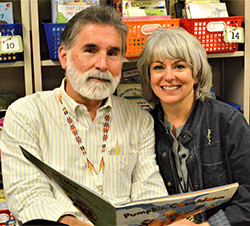Second-graders Leonel Santiago and Carlos Saldana hit an exciting benchmark this fall: They started reading their first chapter books.
Besides helping them learn the important time concepts of “first, next, after that and finally,” said Bonnie Biggs, a retired Kent City teacher, “the goal is to keep them reading.”
Along with her husband, she returned to the system to work under a migrant services grant this fall.
Leonel and Carlos are two of approximately 50 migrant students this year who attend district schools only during a few months, from when school starts through late fall.
“It is important that they want to keep reading when they aren’t here,” Biggs said.
Her husband, Courtney Biggs, works with upper elementary students under the same grant. He said an important part of his job is to figure out what the students like to read.
“In the case of many migrant families, the parents are very involved and they want them to have the tools to succeed,” said Courtney, who previously worked for the Grand Rapids Public Schools Native American educational program for over 10 years. “We are just a part of their support system and help validate the importance of reading.”

‘The Cherry on a Sundae’
The program that the Biggses are involved is part of the school’s Title 1 Federal Grant for Supplemental Migrant Education Programs. Specifically designed to encourage children to read after they leave the school, it is only one of several migrant education programs offered by the district, according to Will Lepech, director of migrant services.
“Migrant education services were started by the state over 50 years ago, but there is always more we can do,” Lepech said.
He likened the migrant grant programs to “the cherry on a sundae.” Children from migrant families are entitled to pull-out services, language services and at-risk services if needed. Even if they are given all of those, they are also entitled to special services for students who migrate for family work, he said.
Bonnie Biggs spent 30 years as a classroom teacher at Kent City Elementary and knows the importance of reading well to education in general.
Courtney’s past experience working with children who struggle with identity issues convinced him that schools should do everything possible to encourage their desire to read.
The couple has chosen a retirement home outside the Kent City area, but they are making sure they leave a mark on the children who live and attend school there part-time.
“Research tells us that every time kids are in a migratory move, they lose about three months of learning,” said Lepech.

Choice Matters
Research shows that choice is a big factor in learning and retaining reading, he added. The purpose of this program is to provide “reading identity” — helping to identify what the child likes to read — and it seems to be making a difference.
“I have been very impressed with some of our kids,” said Bonnie. “When they came back in this fall, I thought that after being away they would lose a lot, but they really proved me wrong.”
Courtney also said he has noticed some excellent reading from the students that he worked with last spring and again this fall. “We are really lucky to have a half hour of one-on-one reading; they just don’t get that opportunity in the regular classroom,” he said.
Working one-on-one bolsters reading identity by allowing the school to purchase materials while the migrating students are out of the district, according to Lepech.
“When we find out their interests, it gives us the opportunity to gather materials specific to those interests and have them available when they return,” he said. “It is kind of a bait-and-hook approach.”
Since it is only the second year for the program in which the Biggses are involved, statistics from reading scores are not available. However, said Lepech, “we have certainly seen a change in reading attitude.”
CONNECT










